Skopelos: Greece’s emerald isle more than “Mamma Mia!”
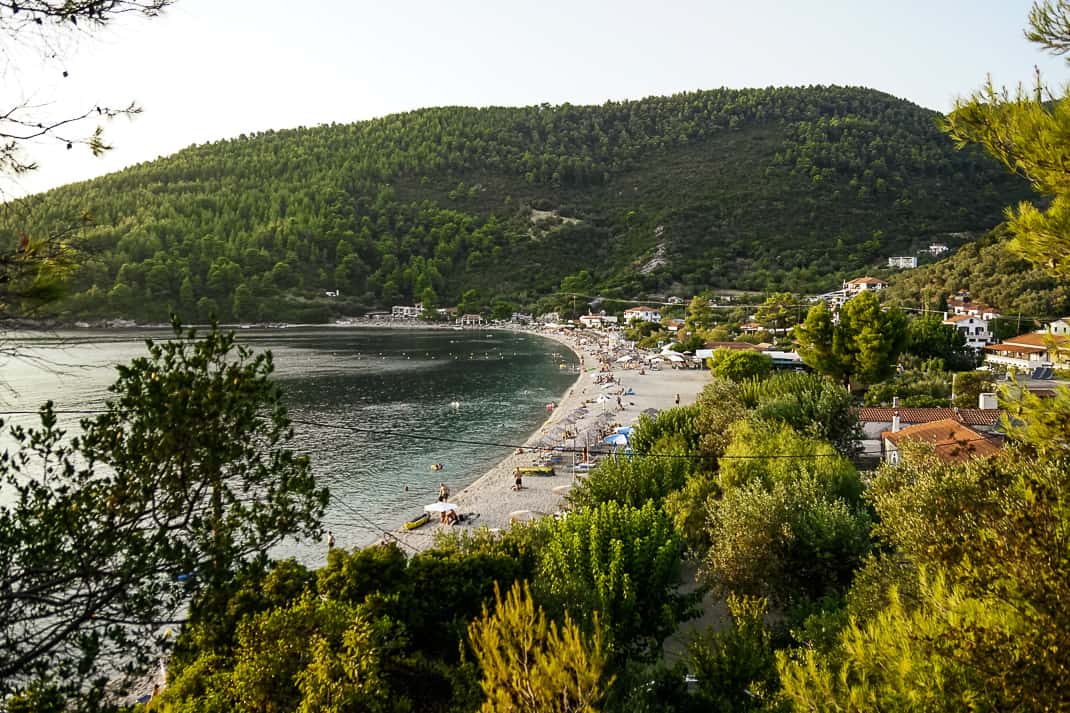
PANORMOS, Greece — Have you ever seen green so deep and rich that it’s hypnotizing? Where you must shake your head so your eyes adjust to the green undulating blanket unfolding in front of you? Trees so thick they look like they all share the same roots? So much shrubbery and vines hanging from branches they form a total eclipse of the blue sky above them?
This is Skopelos. It’s the Greek island that mass tourism forgot. It’s where Mother Nature stomped her foot on the earth and shouted to mankind, “NO! YOU WILL NOT TURN THIS ISLAND INTO A WATER PARK!”
Skopelos is the greenest island in Greece. Located 90 miles north of Athens in the Sporades island chain, Skopelos is made up of 80 percent forest. The Greek government has regulations against deforestation and Natura 2000, a European Union environmental agency, lists it as a protected nature area.
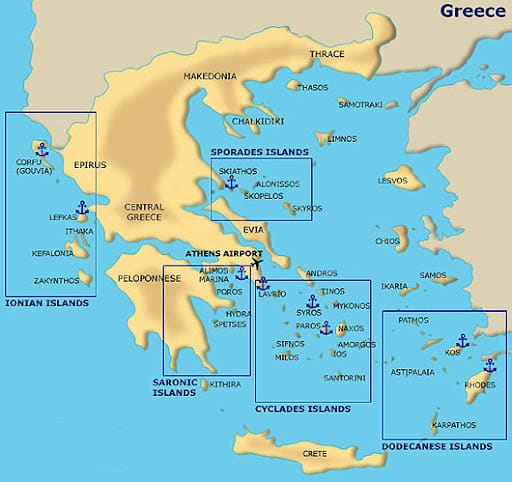
I know green. I was born, raised and educated in Oregon. Nearly half the state is forest. I worked in Washington, the Evergreen State. Twice I’ve been to the Amazon Jungle where the green is so thick it’s actually intimidating. One time taking a boat upriver and not seeing enough space between trees to dock a dinghy, I told the captain, “You could hide a lot of bodies in this jungle.”
Skopelos isn’t the Amazon. But its vegetation reminded me of it. Greece is known for having the best beaches in Europe, for islands distinct in their geography and history. But Skopelos stands alone in its sheer, over-the-top nature.
It is Greece’s Evergreen Island.
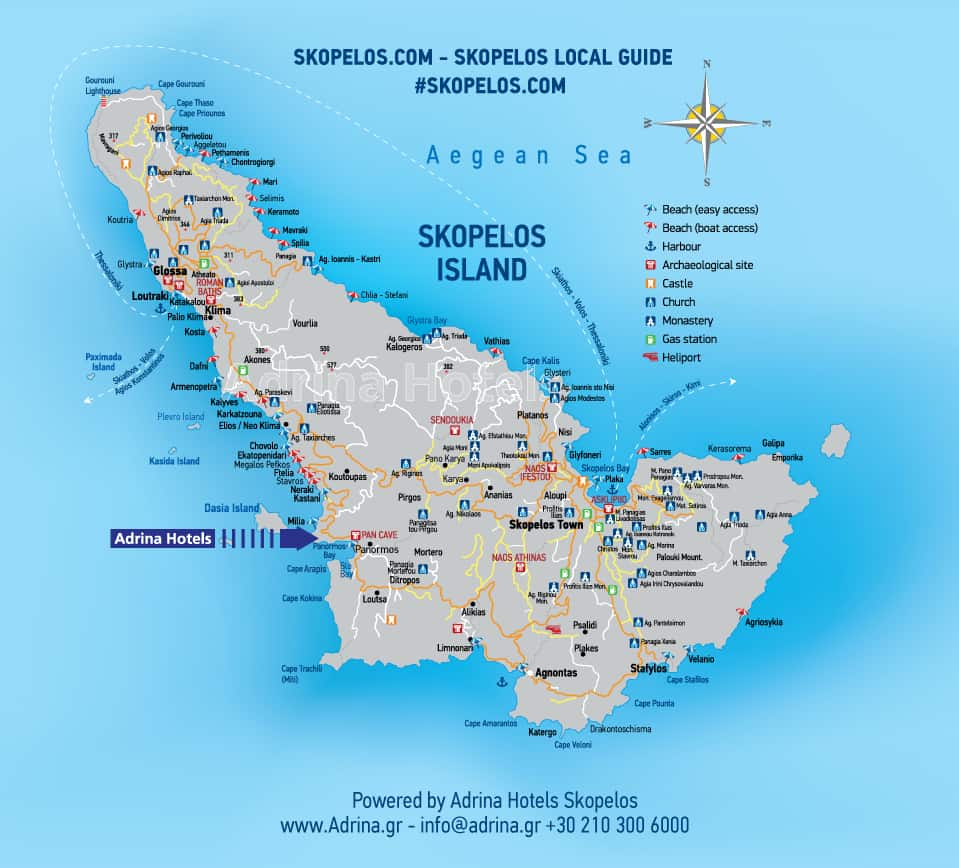
Why Skopelos?
Marina and I came here as part of what is turning into our annual August Greek getaway. We had twice visited Skiathos, one of the other three Sporades islands, and on our last visit in 2019 we took a day trip to Skopelos, a 50-minute ferry ride away. We fell in love with the quiet port, the beautiful undeveloped beaches, the smaller crowds.
We booked a week on Skopelos for last year. However, Covid not only knocked out the trip, it KO’d the airline, too. Blue Panorama had flown direct from Rome to Skiathos for years but it eliminated its Greek destinations and forced us this year to take the scenic route.
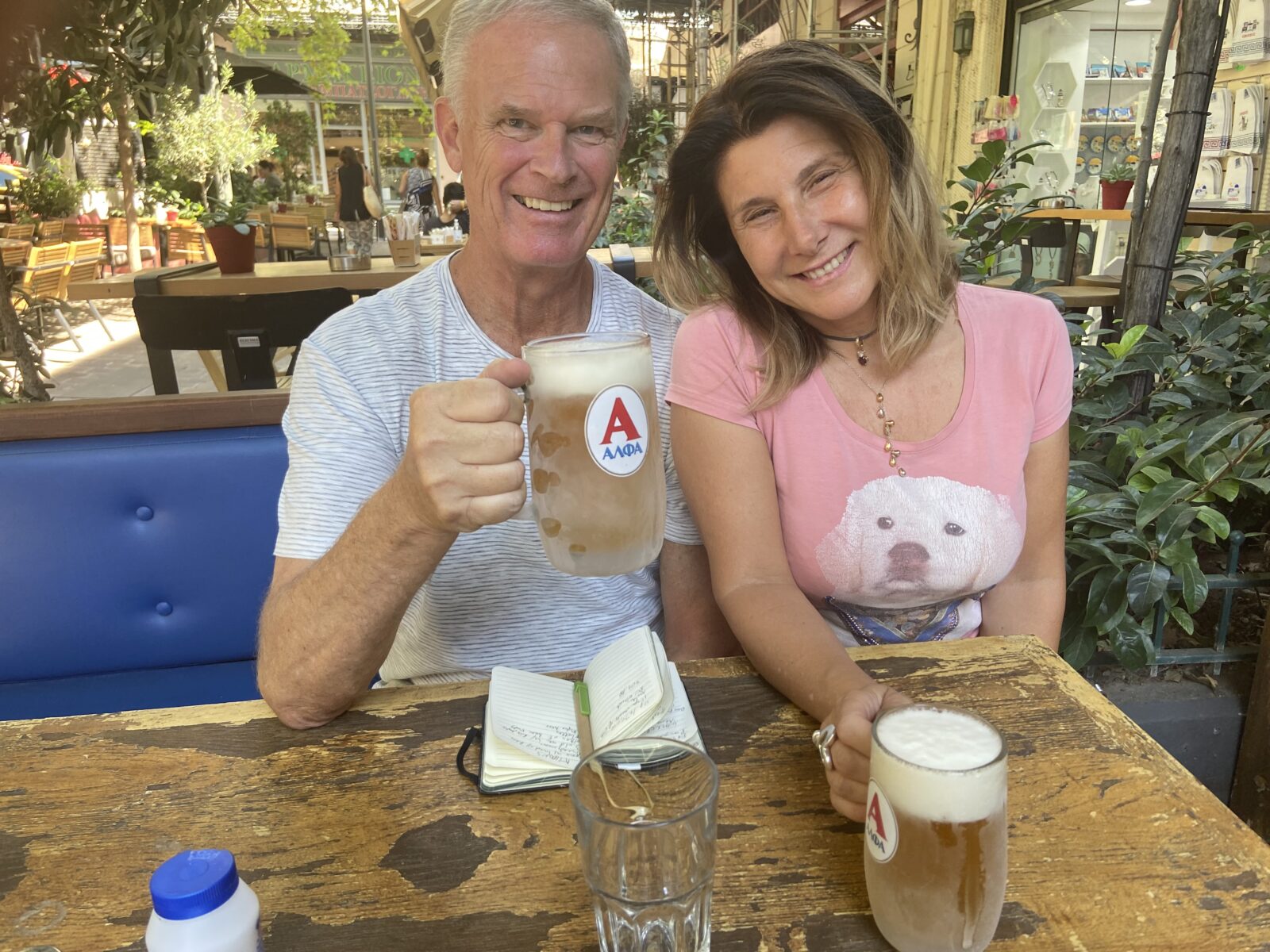
We flew Aegean Air two hours to Athens, where we had to spend the night (albeit in a beautiful hotel in the Plaka with a rooftop bar view of the Acropolis, which seems even more mysterious after some ouzos on the rocks.) The next morning we took an overpriced 40-minute Sky Express flight to Skiathos where we waited 3 hours and 20 minutes for the ferry to Skopelos, arriving at our hotel nearly 30 hours after leaving Rome.
That was the easy part. Getting to Greece in this time of Covid is not for the impatient or unvaxxed. Greece not only requires proof of vaccination to avoid a five-day quarantine but ALSO a negative Covid test which they make random passengers take upon arrival. To avoid the possible 10-day quarantine for a positive test, Marina and I tested in Rome the day before just to make sure we were safe. We were.
Then came the hard part.
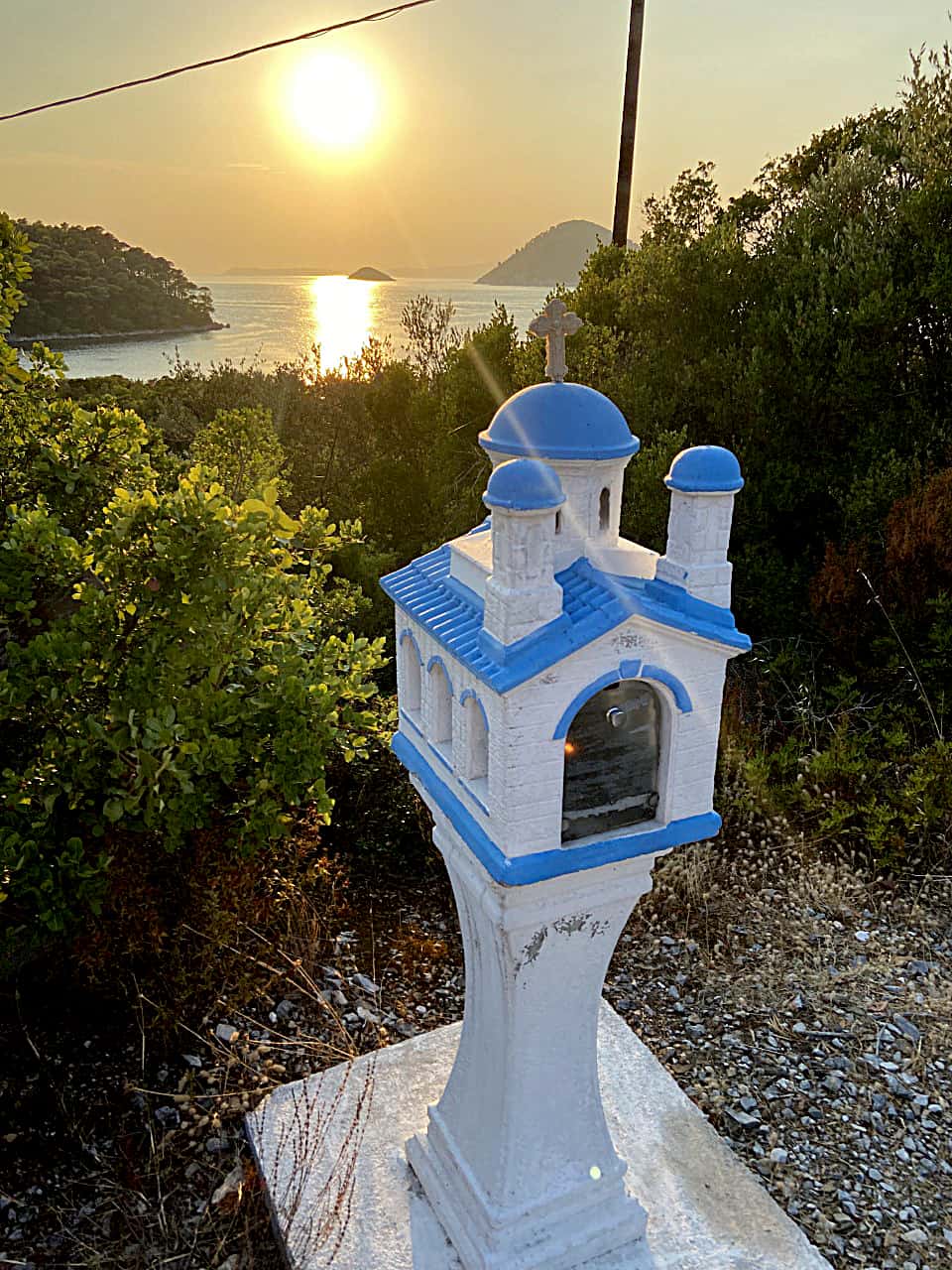
Every arriving passenger must fill out a PLF, the European Union’s mandatory Passenger Locator Form. It’s a five-page online form where we wrote our personal information, emergency contacts, where we’re coming from, where we’re going, where we’re staying, our transportation info, previous countries we’ve visited and height for the casket in case of Covid death. I made up the last part but Greece is serious. We saw one family of five get turned away at the Athens airport for not filling it out.
The measures have worked. Greece has had only 584,000 cases (compared to Italy’s 4.5 million and the United States’ 40 million) and 13,600 deaths (compared to 129,000 and 656,000, respectively).
On Skopelos? It’s practically Covid free. Since the pandemic began, the island of 5,000 people has had fewer than 100 cases. Nearly 90 percent of the population had been vaccinated by May. Not one person has died.
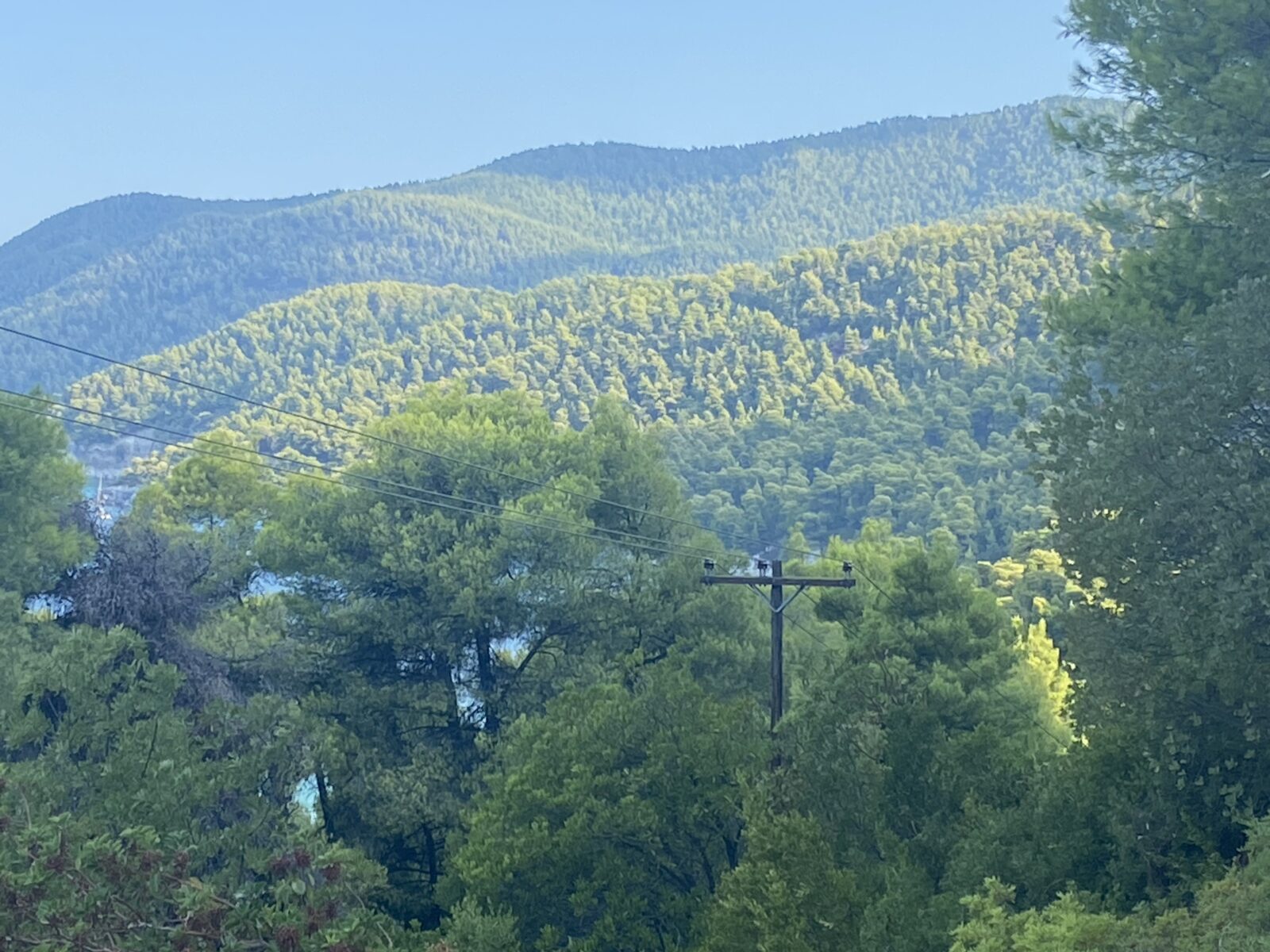
The arrival
When we hopped into the taxi at Skopelos’ quaint port for the 20-minute ride to our hotel, we learned that all the delays, tests and time were worth it. We climbed into hills that became greener the higher we drove. Thick forests crept high on both sides of the two-lane road. Pine trees. Olive trees. Plum trees.
Off in the distance, we saw the royal blue of the Aegean Sea.
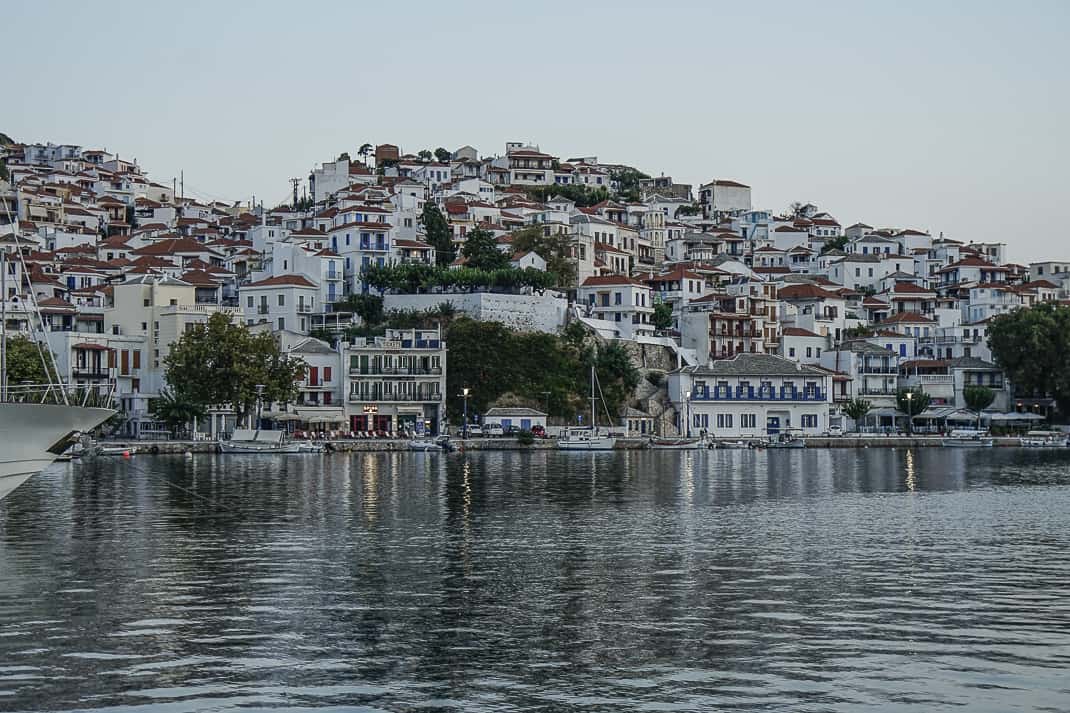
The sky was the color of the stripes in Greece’s flag. The famed fires that burned 121,000 acres in Evia, the island just south of here, were put out a week prior to our arrival. Not a single tree on Skopelos appeared touched.
Zach, the cab driver, is a 54-year-old Skopelos native and one of its biggest fans. He has lived here almost his entire life and wrote a beautiful hard-cover picture book called “Skopelos Island Beyond Your Eyes.”
“I like to live here all the time,” he said. “This is my paradise. The island inspires me for my photography activity. This place apart from its breathtaking beauty, possesses also a soul and a pulse.”
After 20 minutes, his cab took a final turn and as we descended a hill we looked down at our village of choice. Panormos, Greek for “sheltered harbor,” has all of 50 residents and hugs a 100-meter-long stretch of beach backed by a mountain of trees and a few small random structures. The forest stretched up about 400 feet, dwarfing the beach and buildings like a green wall over a few pebbles.
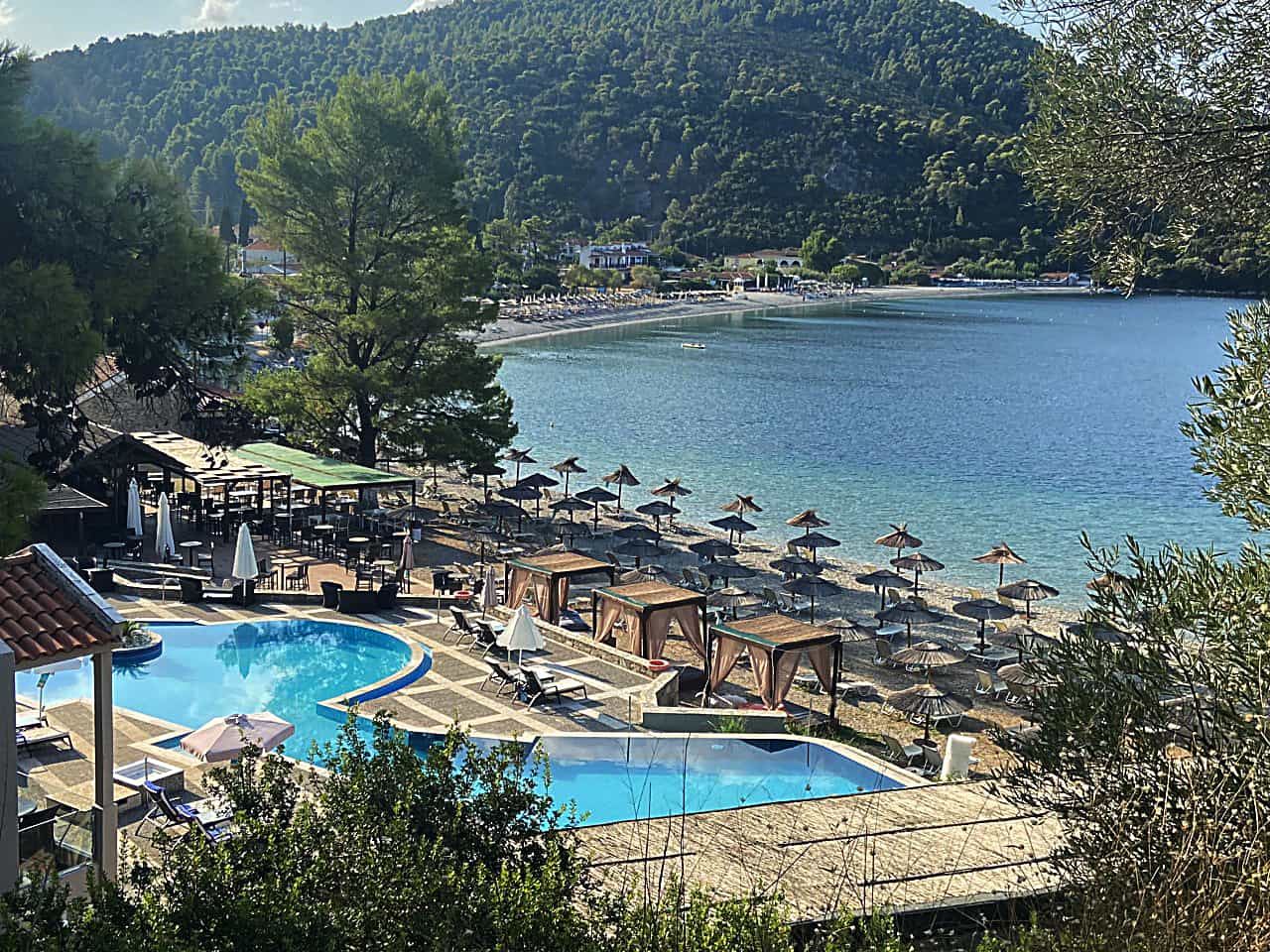
Panormos is one of about two dozen villages dotting the island, all designated by little entering signs and then exiting signs 60 seconds later.
Our Aphrodite Hotel is set back from the beach about 100 yards down a paved alley. Walking toward the hotel felt like we were walking into a set of “The Hobbit.” At the hotel entrance the alley continued into a sea of green. You could film a dozen nature documentaries in these forests.
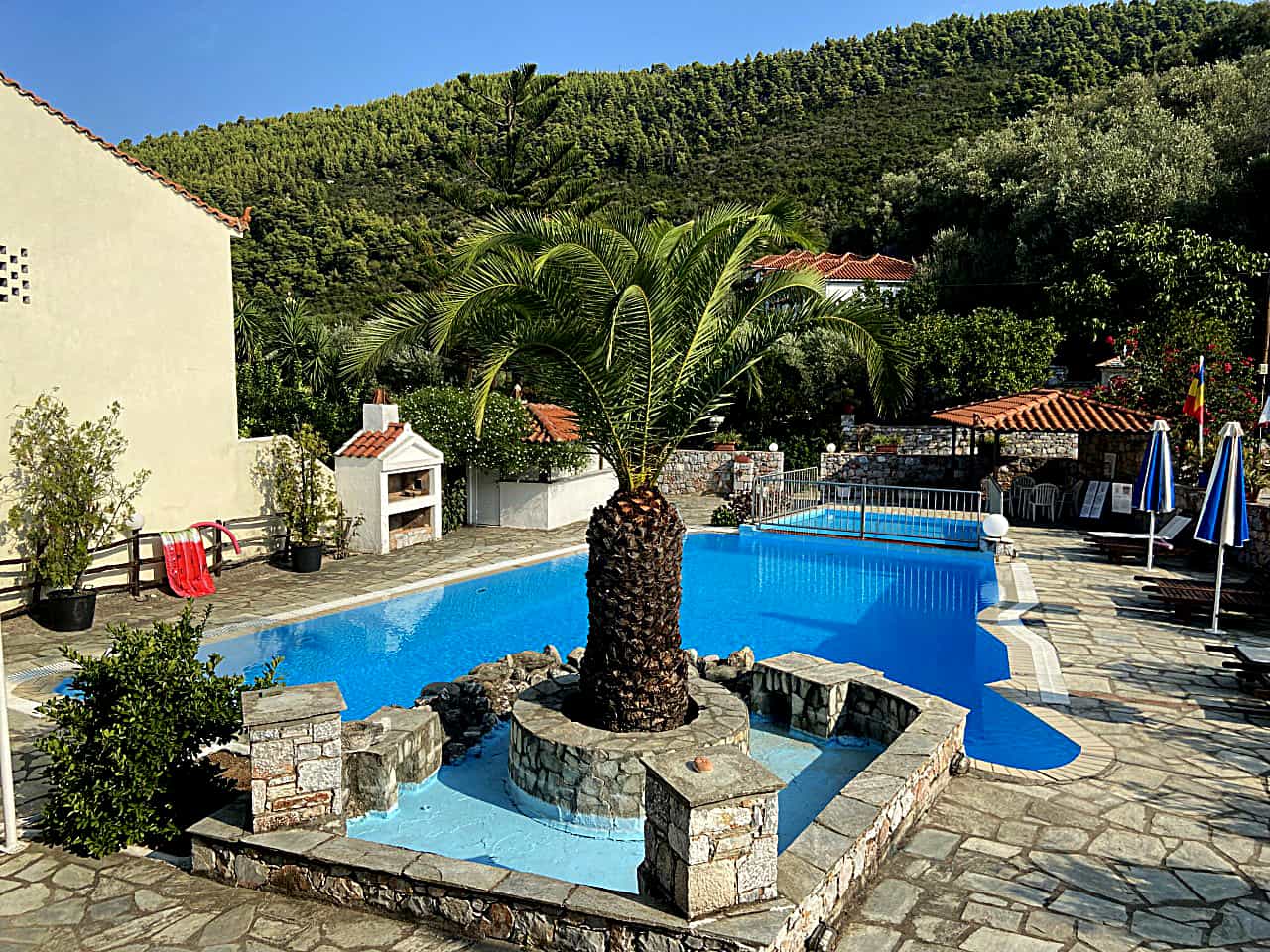
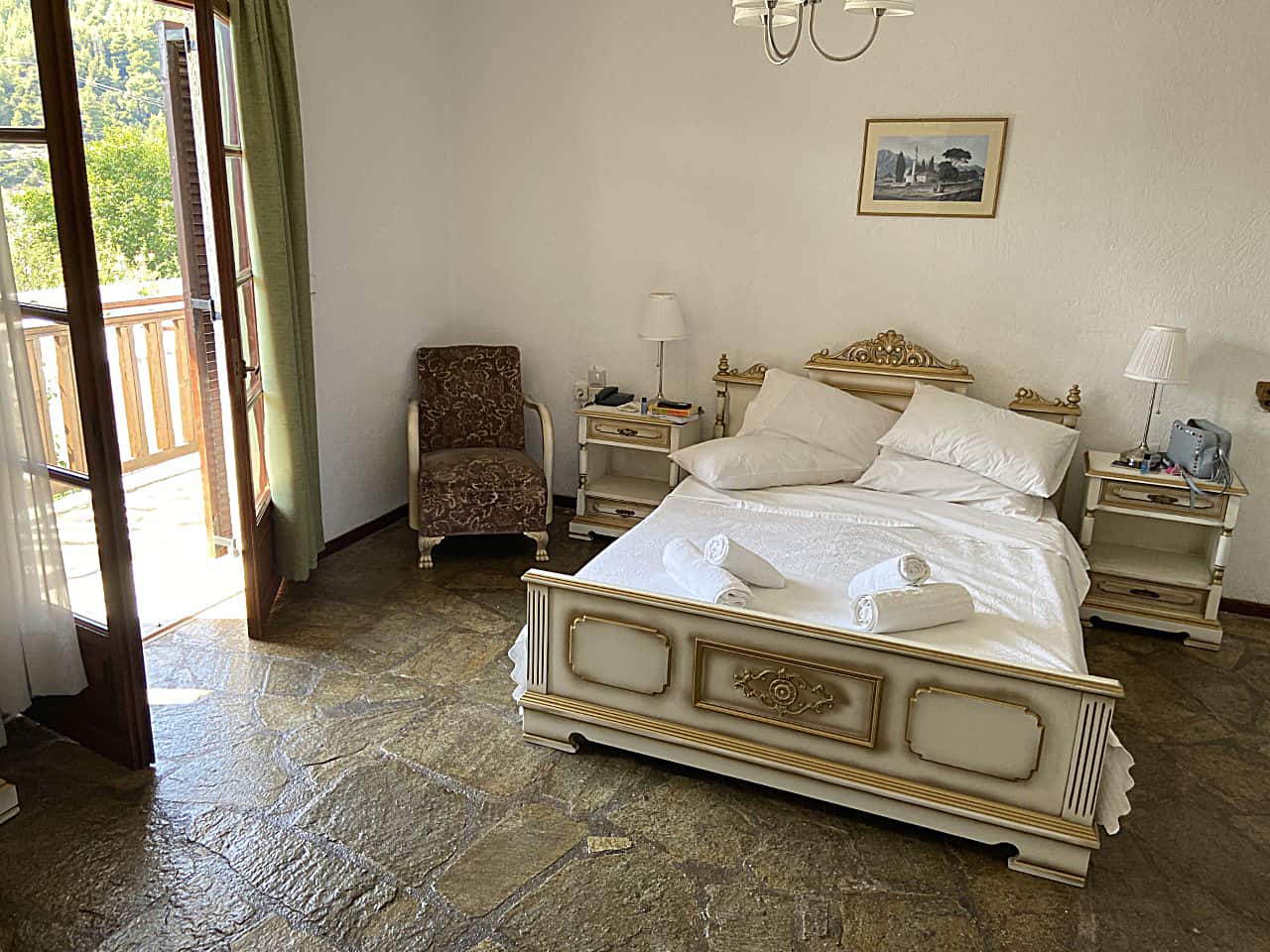
The room had a spacious balcony and we took our buffet breakfast onto a breezy veranda overlooking a deep pool. The location could not have been better if we wrote the script. Just 100 meters off the beach, it was so quiet all we could hear were the leaves rustling in the many trees.
Where the alley met the main road at the beach, the Dolphin at Skopelos restaurant served these delicious Greek meatballs. Next door was the cheap, rough-and-tumble Taverna Vasiliki where we lunched on gyros pitas for 6 euros and on the other side of the alley stood Kraken. That’s the village’s lone bar where locals drank their morning coffee and I’d have an afternoon ouzo as soft rock music played in the background.
Skopelos also taught us something about travel in Greece. When visiting, pick a village facing west. Panormos’ beach is lined with terrific restaurants. On our first night, we took a table at the romantic Lenarakia, where we had drinks while watching the blood red sun set on the horizon. We walked about 100 yards to Yoannis where we had a candlelit table on the rocks. Two young Greek couples flirted in the surf under a full moon. I had chicken souvlaki with lemon juice and more ouzo as Greek music played.
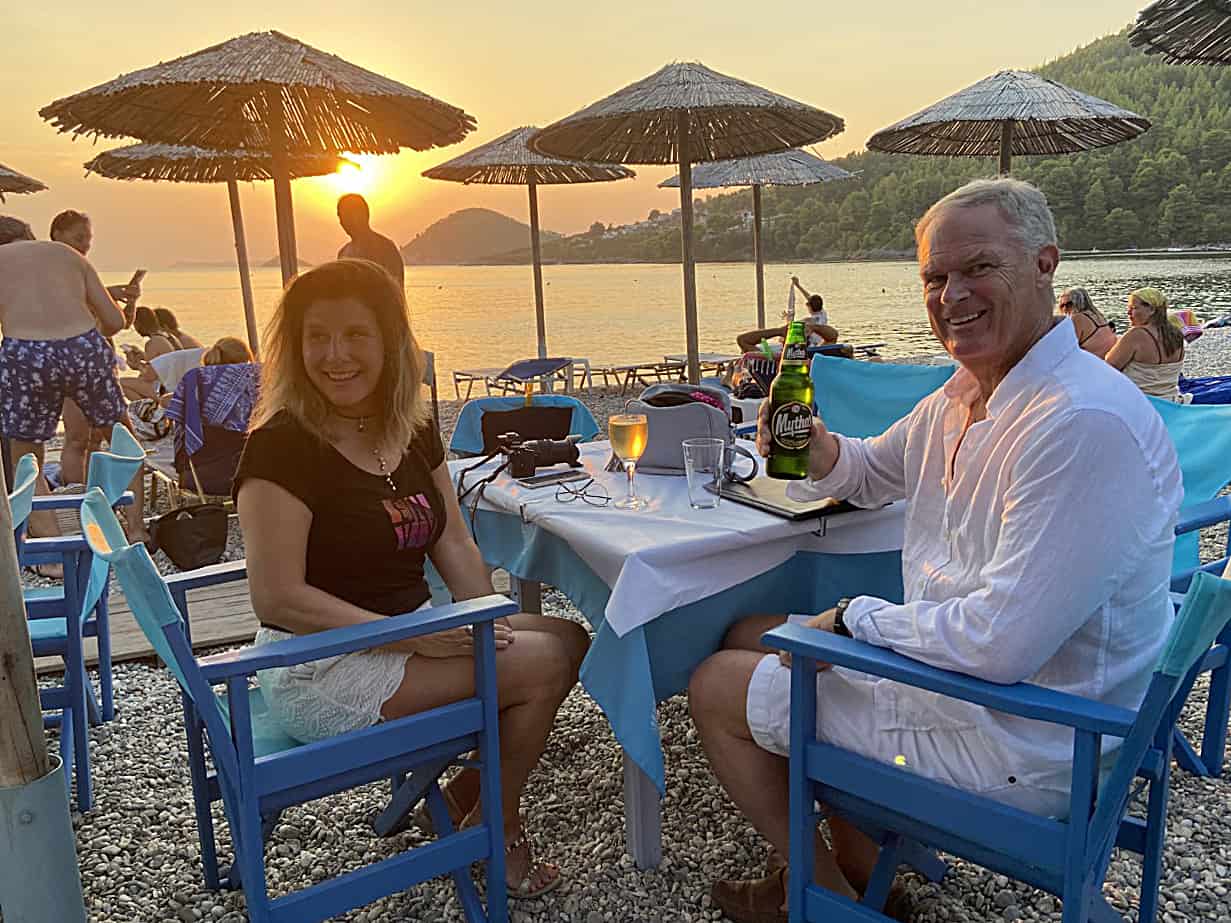
Marina and I have been all over Greece, both together and separately. At one point we stood at the main road, looked at the Aegean in front of us and the forest behind. It was low 80s with low humidity and the sky was the color of the South Pacific. We turned to each other and said simultaneously, almost subconsciously.
“I’ve found my new favorite Greek island.”
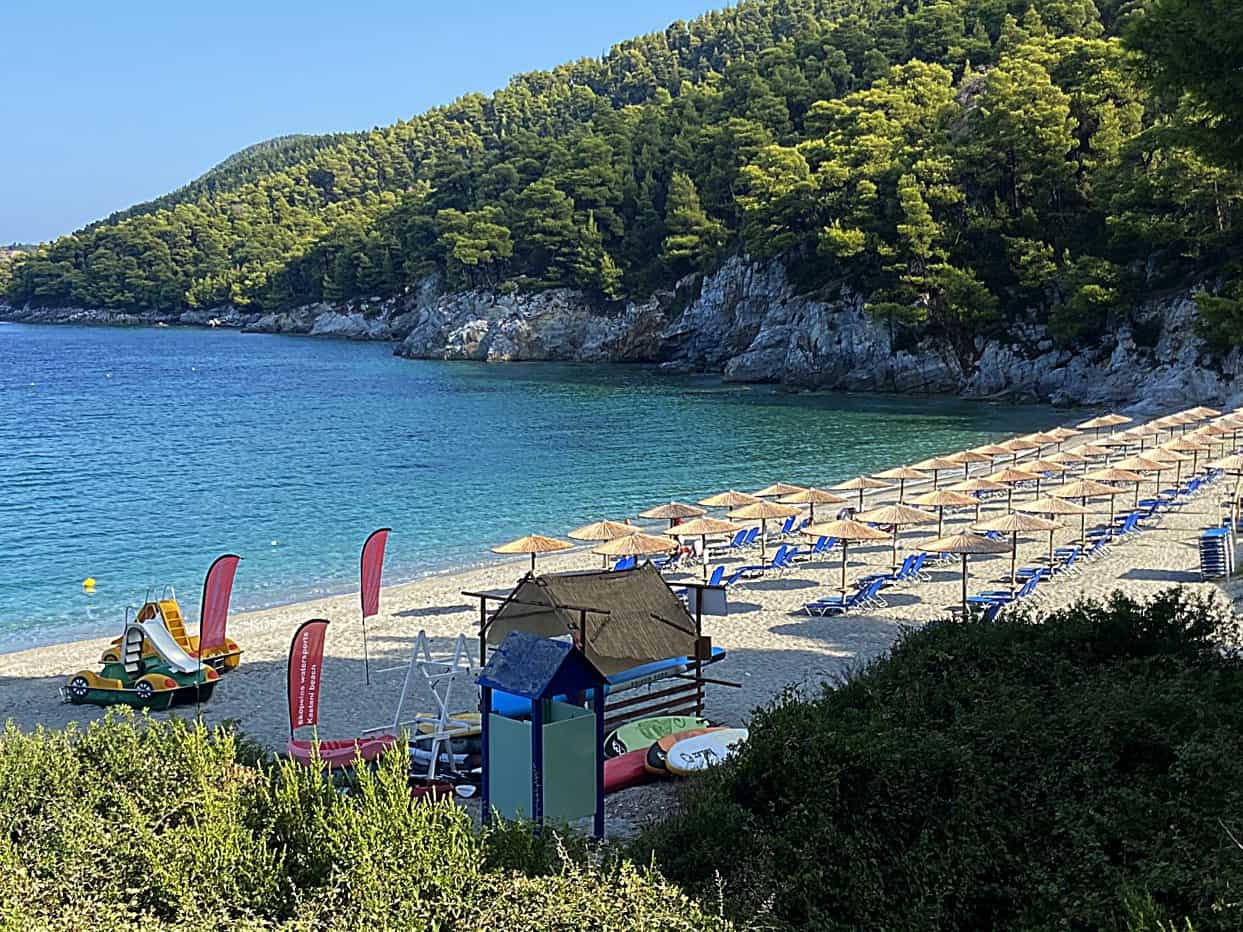
The beaches
Skopelos is all of 37 square miles, smaller than Grand Junction, Colo. Yet it has 18 beaches. In other words, you could go to a different beach every day for two weeks and still not hit them all. The island is shaped like a saxophone, with protected beaches and coves in the southwest and southeast and long straight stretches in the north. Each little cove and beach is separated by rocky outcrops and from villages by the main road or a short dirt trail through the forest.
Greek beaches, however, are not for everybody. As an American, I became spoiled by beaches in the Caribbean, California, South Pacific and Hawaii. Long, golden-sand beaches without a pebble in sight. Not a lounge chair, either. Even my native Oregon, despite Pacific Ocean temperatures that can cause impotence in brahma bulls, the beaches are broad and big and beautiful.
In Greece, sand isn’t a given. In Skopelos, some beaches don’t have enough sand for a box of cat litter. Many are all rocks. And nearly every beach is lined with lanais chairs. While as an American I found it sacrilegious to pay to lay on the beach, after 7 ½ years in Europe I’ve become used to it, kind of like waiting 30 minutes at the post office to pay bills.
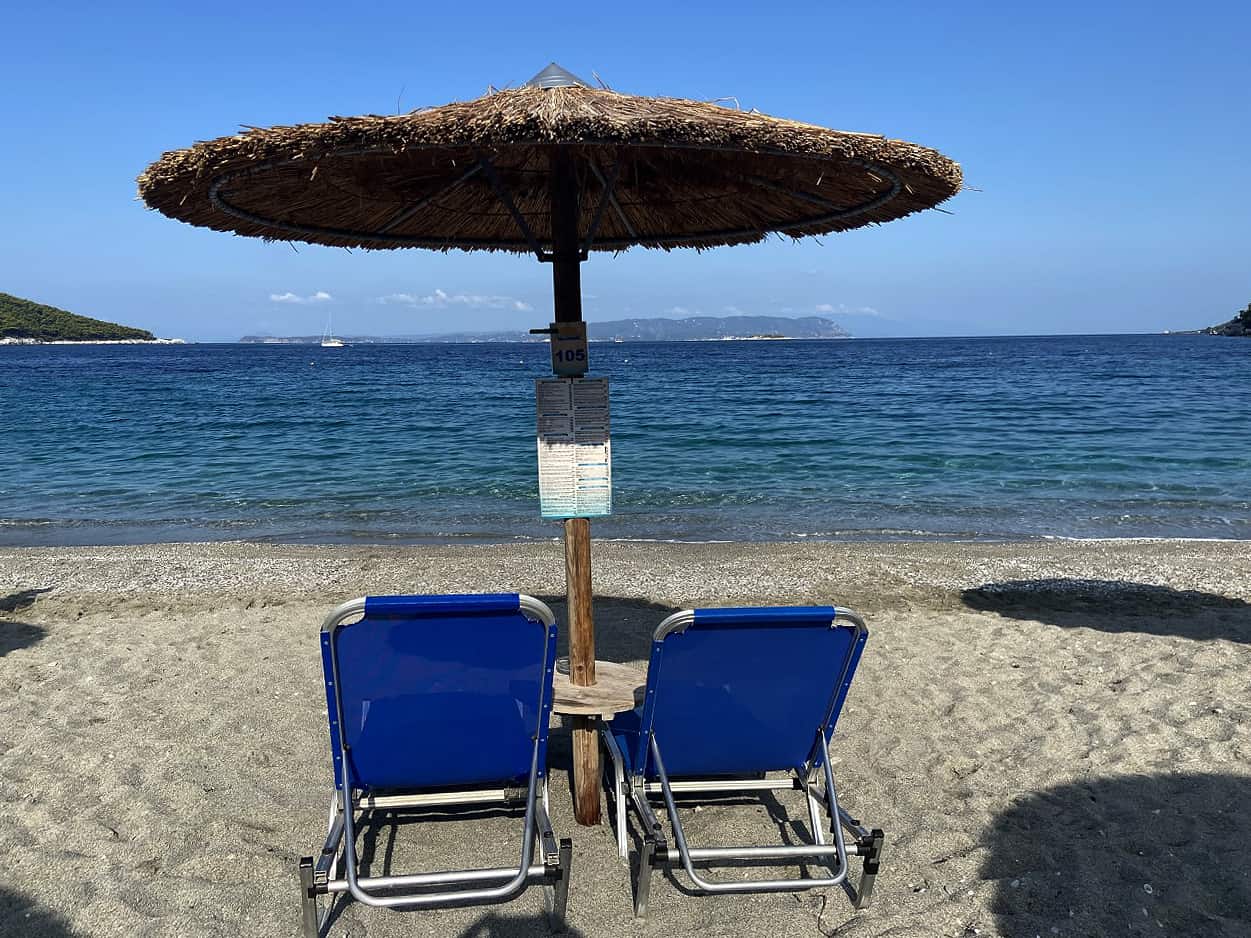
Every day we paid 7 to 15 euros for two lounge chairs and an umbrella. On the plus side, reading good books is easier sitting up than laying down. Also, rocky beaches have an amazing effect on the water. It’s crystal clear. Sand doesn’t make it murky. The sea gets deep here quickly. (Non swimmers beware.) Yet in 15-20 feet of water, I could still see the bottom.
Going to Greek beaches, however, has a strategy. It’s August in Greece. Tourists are back. Last year, Skopelos lost an estimated 80 percent of its economy when the island shut down. But not one business closed and every one reopened to welcome back visitors whom local authorities say have already made up about 70 percent of the business from 2019.
That’s the good news. The bad news is every beach was full by 11 a.m. By mid-afternoon, the lanais chairs had waiting lists. It all looked like an 1950s aerial photo of the Jersey Shore.
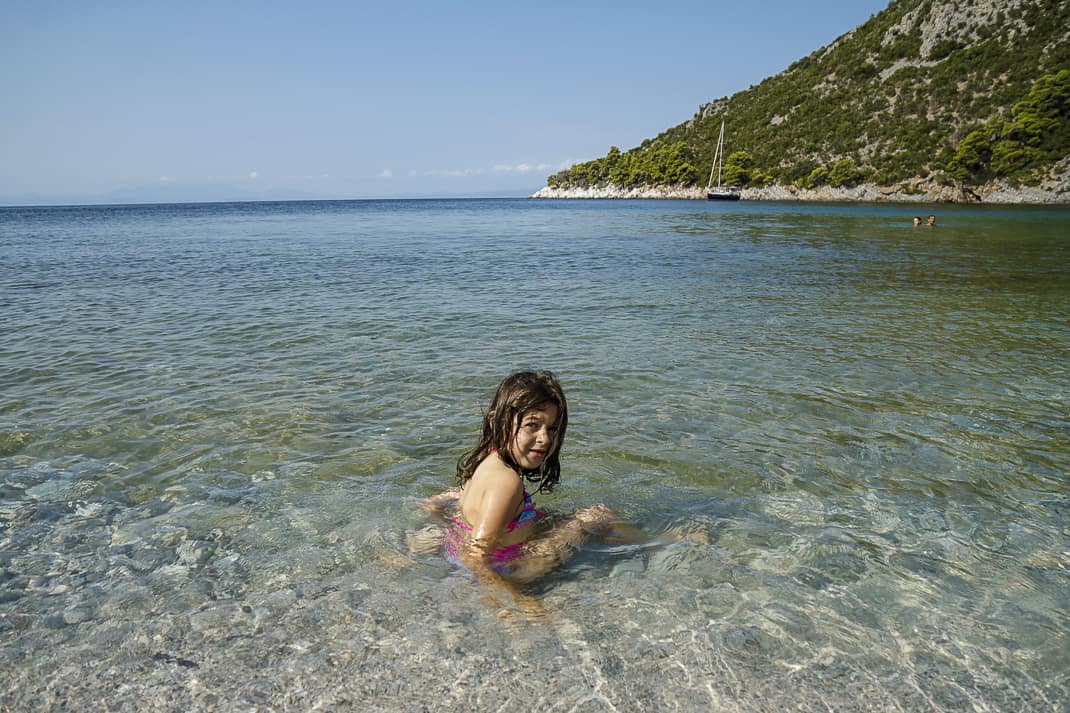
Marina and I came every day at about 9 right after breakfast. At our beach at the end of the alley, we walked to an empty expanse of Aegean Sea. A lone jogger ran by. An elderly couple sat in the sun climbing in a bright blue sky. Marina and I had the Aegean, as flat and calm as a volcanic lake but as warm as a bathtub, all to ourselves.
One morning we walked the 2.7 kilometers to Kastani, the most popular beach on Skopelos. We saw few cars pass along the country highway as we skirted the jungle on both sides of us. The trees were so thick, we couldn’t see the sea below us. A small service road curved down through the trees and we soon saw this gently curving beach with — GASP! — sand!
Walking barefoot without requiring flip-flops or, better yet, military boots made Kastani my favorite beach. However, most people love it because it was the site of the dancing scene from “Mamma Mia!” the God-awful Meryl Streep-Pierce Brosnan chick flick about a Greek wedding. It put Skopelos on the world map in 2008 and turned weddings here into a cottage industry. (I will dive into Skopelos weddings next Tuesday.)
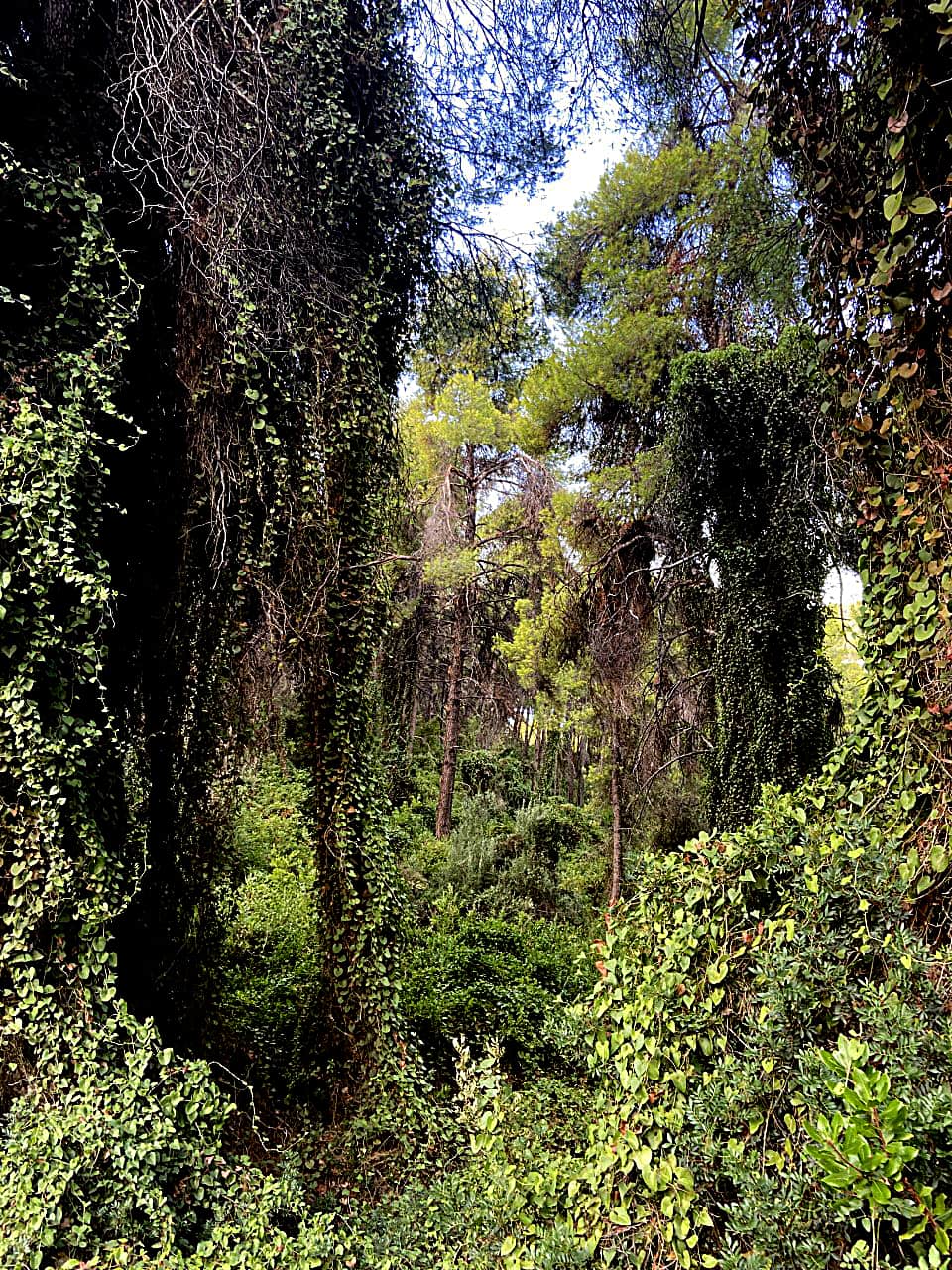
I did not dance on Kastani. I laid in the brilliant 80-degree sunshine, read my Carl Hiaasen novel and swam in the warm sea. By the time people were lined up waiting for chairs, we were gone.
The history
According to legend, Skopelos was founded by Staphylos, Greek for “grape” and the son of Dionysos, the Greek God of Wine. Not coincidentally, Skopelos today makes a very good white wine called Savatiano which is a nice alternative to the better known vile swill called Retsina.
Over the next 2,000 years Skopelos would become the pass-around pack for conquering empires. They were ruled by Athens, Macedonia, Rome (both Republic and Empire), Byzantium three times, Constantinople, Ottoman twice, Venice and maybe Real Madrid.
After World War II, most men on the island left for Athens to help turn the capital into a concrete jungle, leaving the remaining islanders poor and desperate. It wasn’t until the late 1960s when a German pilot flew over the island and decided to buy land. Soon the first hotel, the Aeolos which still stands, was built.

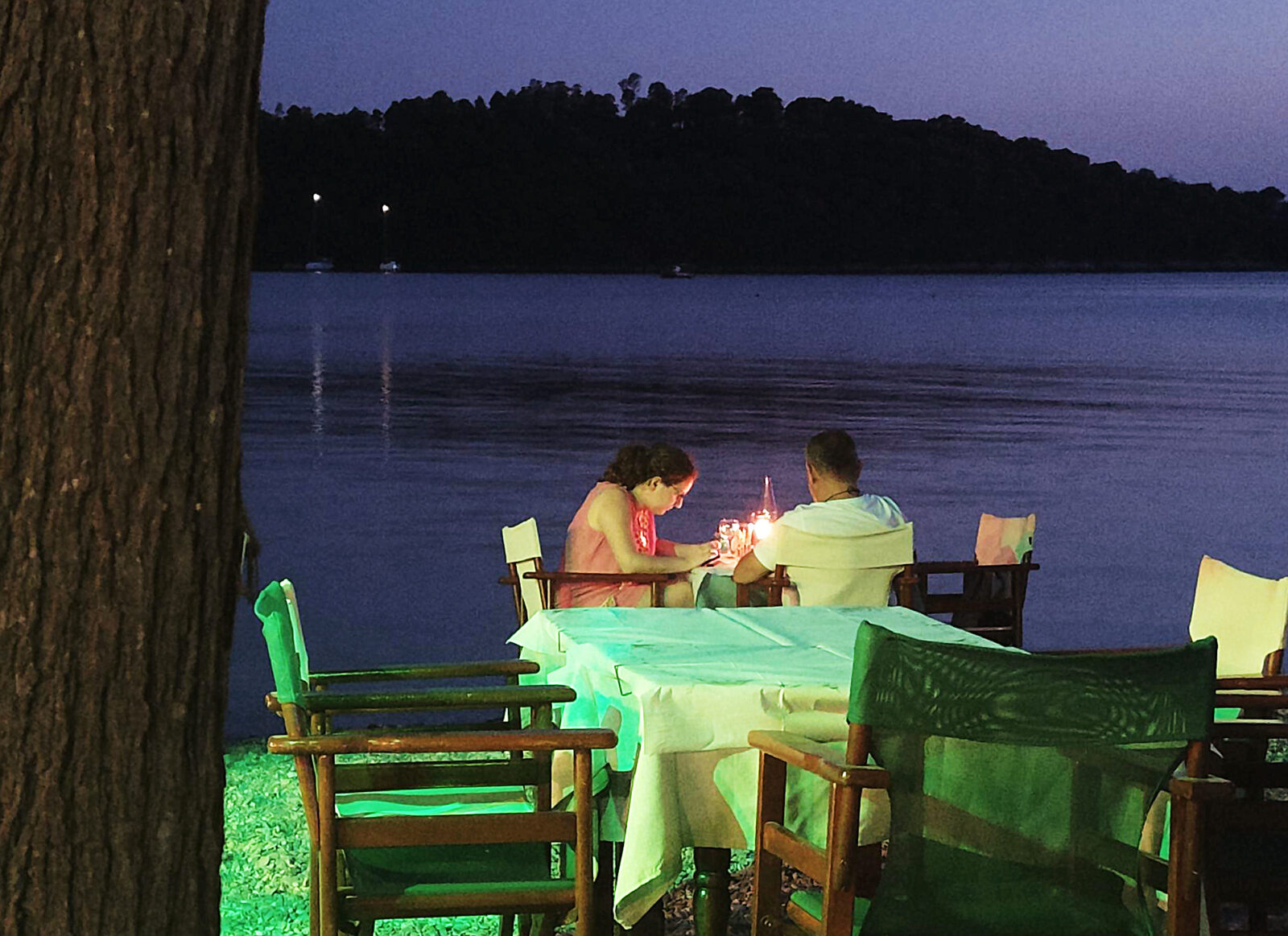
In the late ‘70s, people began renting houses and in the ‘80s and ‘90s Skopelos became a destination for retirees around Europe. Plums and fishing became industries but today tourism makes up the vast majority of the economy.
Locals and expats live harmoniously. The wealthy retirees stayed during the pandemic. Now the whole island is exhaling. Tourism is back and so is the economy. But that’s not why the locals are smiling.
“Here in Skopelos the people, it may be strange, but they’re not kind and friendly to you because they see the money,” said Ildi Matus, a Slovak who has lived here 14 years and runs MagicCars rental service with her Greek husband, Ioannis. “They are so proud of the island and they are so happy that you’re here. So when you come here you enjoy your stay, they want you to have the same feeling they have about their own island.
“Also, the places like restaurants and hotels, they are owned by people from the island. It’s a big difference. They are not from abroad. Here they care about you more. They don’t want you to go away feeling that something was missing. I was a tourist from the beginning. Now I’m not a tourist. They accepted me for what I am.”
Marina and I felt accepted, too. That’s good because we’ll be back. It will be our new Greek getaway.
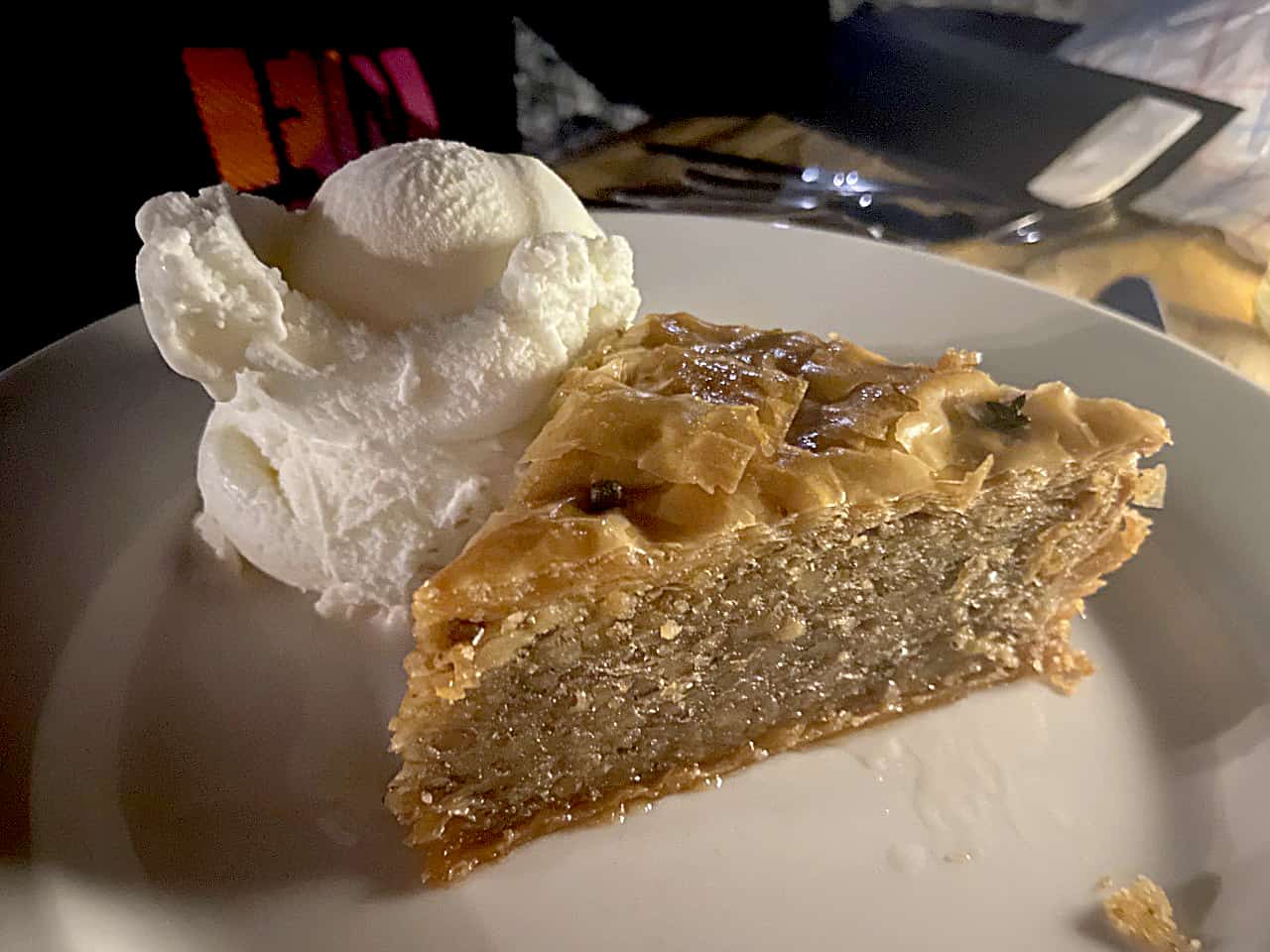
In case you’re going …
How to get there: Athens has numerous flights per day to Skiathos. I paid 417 euros for two round-trip tickets in August through Aegean Air. The price drops in September. Numerous ferries leave from Skiathos to Skopelos. I paid 26.50 for two one-way tickets. Reservations recommended.
Where to stay: Aphrodite Hotel, Panormos Village, 30-24240-23152, www.afroditehotel.gr, info@afroditehotel.gr. Three-star hotel 100 meters off beach. Spacious rooms with balcony. Breakfast buffet included.
Where to eat: Taverna Vasiliki, Panormos Village, 30-698-694-0316, 10 a.m.-midnight. Our go-to place for cheap, authentic Greek cuisine across street from beach. It’s where locals go. Meals starting at 6 a.m.
Dolphin of Skopelos, Panormos Village, 30-242-402-4304, delfini1960@gmail.com, 9 a.m.-midnight. Somewhat elegant restaurant with gourmet Greek dishes at reasonable prices. Next door to Vasiliki.
Flisvos Restaurant, Glossa Village, 30-242-403-3856, flisvosrestaurant@gmail.com, noon-midnight. On stone platform over water in village closest to the Agios Ioannis church of “Mamma Mia!” fame. Some of best seafood on island. Try the shrimp in sauce of tomatoes, onions and fetta.
When to go: Summer only. Island all but shuts down in winter. Average temperature range in June is 68-77, August 72-80 and September 65-74. Summer months average less than an inch of rain.
For more information: Tourist Police serve as the Greek government tourist information centers. The office on Skiathos is on Ring Road, 8 a.m.-9 p.m.


August 31, 2021 @ 11:31 pm
I want to go
September 1, 2021 @ 8:08 am
Thank you so much for sharing. I must visit this beautiful paradise. I also enjoyed your writing style it was very entertaining, funny and super informative thanks for including us in your adventure(s).
Be safe and stay healthy you guys:).
September 2, 2021 @ 1:09 pm
Enjoyed reading your article. It made me even more proud that we are living here. But I am so happy that you felt the same as I feel about this beautiful island. You are welcome back anytime……thanks again!
October 10, 2021 @ 5:26 am
Up next, Romania….. but Greece next…..
September 16, 2023 @ 1:44 pm
We have been coming to Skopelos for the last 12 years. We love it. This year we decided to spend one whole month on the island and we are loving it. We will be back next year